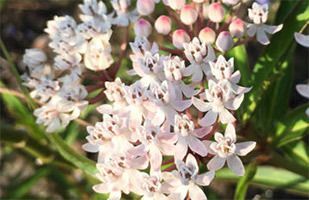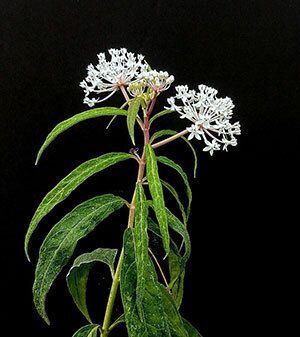Aquatic Milkweed
Asclepias perennis
Family: Apocynaceae (Dogbane Family)
Aquatic Milkweed (Asclepias perennis) is a native perennial milkweed species found in wetland habitats across Southeast Texas. Unlike other milkweeds, it thrives in moist to wet soils, making it a perfect addition to rain gardens and riparian restoration projects. It produces delicate white to pale pink flowers that serve as an important nectar source for pollinators, especially monarch butterflies.
- Scientific Name: Asclepias perennis
- Common Names: Aquatic Milkweed, White Swamp Milkweed
- Family: Apocynaceae (Dogbane Family)
- Growth Habit: Herbaceous perennial
- Height: 1-3 feet
- Leaves: Narrow, lance-shaped, dark green
- Flowers: Small, white to pale pink clusters
- Bloom Time: May – October in Southeast Texas
- Wildlife Benefits: Provides nectar for bees and butterflies; a host plant for monarch caterpillars
Habitat & Range in Southeast Texas

Aquatic Milkweed prefers consistently moist or wet soils and is commonly found in:
- Riparian Zones: Along streams, rivers, and pond edges
- Swamps & Wetlands: Thrives in seasonally flooded areas
- Ditches & Low-Lying Areas: Naturalized in moist roadside and meadow conditions
This species is well adapted to wet environments but can also tolerate short dry spells.
Ecological Importance
- Monarch Butterfly Host Plant: Essential for monarch caterpillars
- Pollinator Magnet: Attracts a variety of bees, butterflies, and other beneficial insects
- Erosion Control: Helps stabilize soil along water bodies
Landscaping & Gardening Uses
Aquatic Milkweed is a great choice for gardeners looking to support pollinators while incorporating plants suited for wet or seasonally flooded conditions.
Planting & Care
- Sunlight: Full sun to partial shade
- Soil: Prefers moist to wet soils; tolerates clay and loamy soils
- Water Needs: High; thrives in wet conditions
- Maintenance: Low; cut back in late winter to encourage fresh growth
- Companion Plants: Pairs well with Blue Mistflower (Conoclinium coelestinum), Swamp Sunflower (Helianthus angustifolius), and Cardinal Flower (Lobelia cardinalis)
Fun Facts
- Unlike many milkweeds, Aquatic Milkweed does not have milky sap.
- It is one of the few milkweed species adapted to wetland conditions.
- Monarchs rely on milkweed species like this as a critical food source for their caterpillars.
Conservation & Native Plant Advocacy
As wetlands face habitat loss, Aquatic Milkweed plays a vital role in supporting pollinators and restoring native plant communities. By planting this species, you contribute to monarch conservation and wetland ecosystem health.
Where to Find It
-
Interested in adding Aquatic Milkweed to your garden? Check if this is in stock or add to cart to purchase directly from our Natives Nursery.



